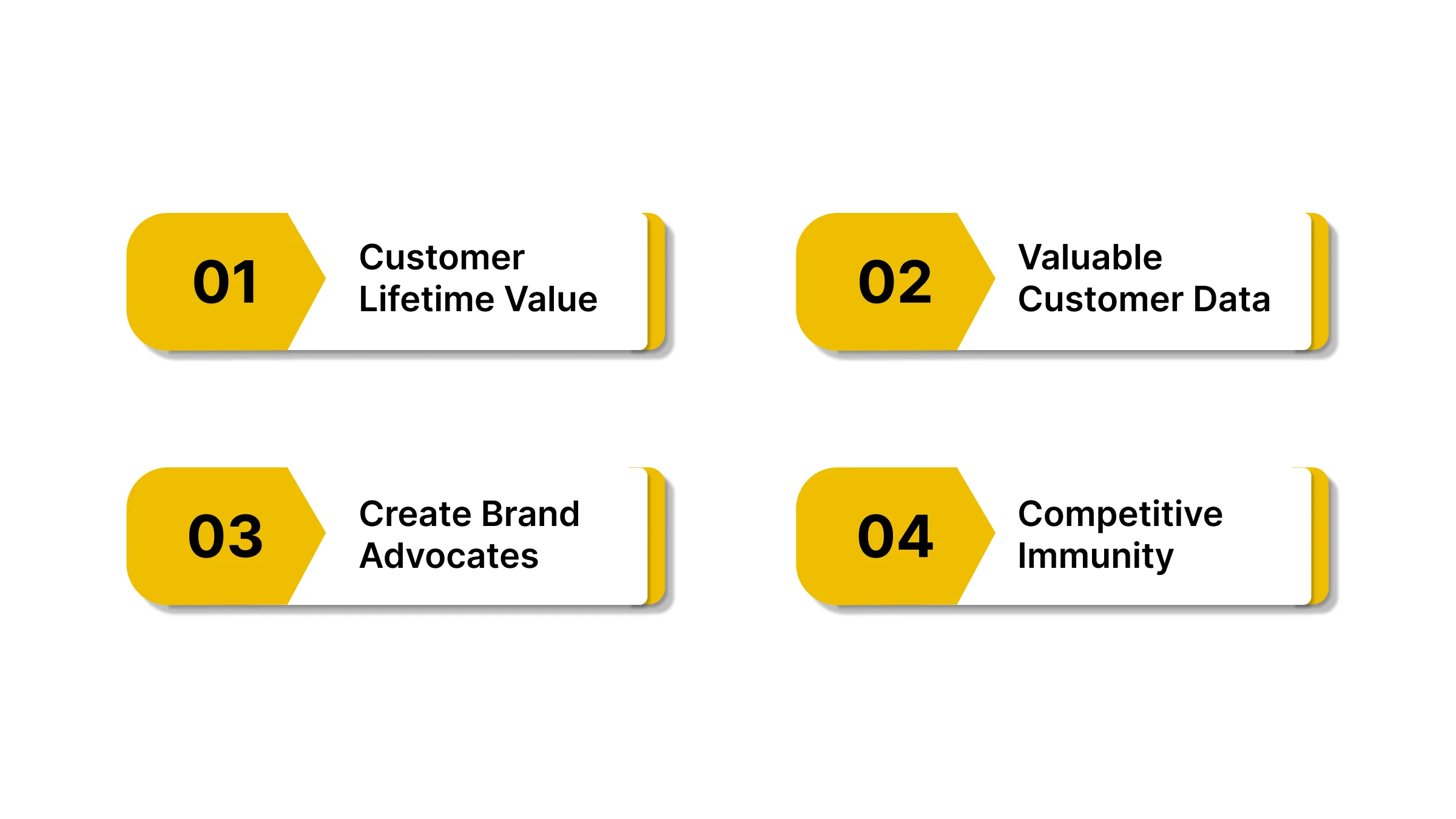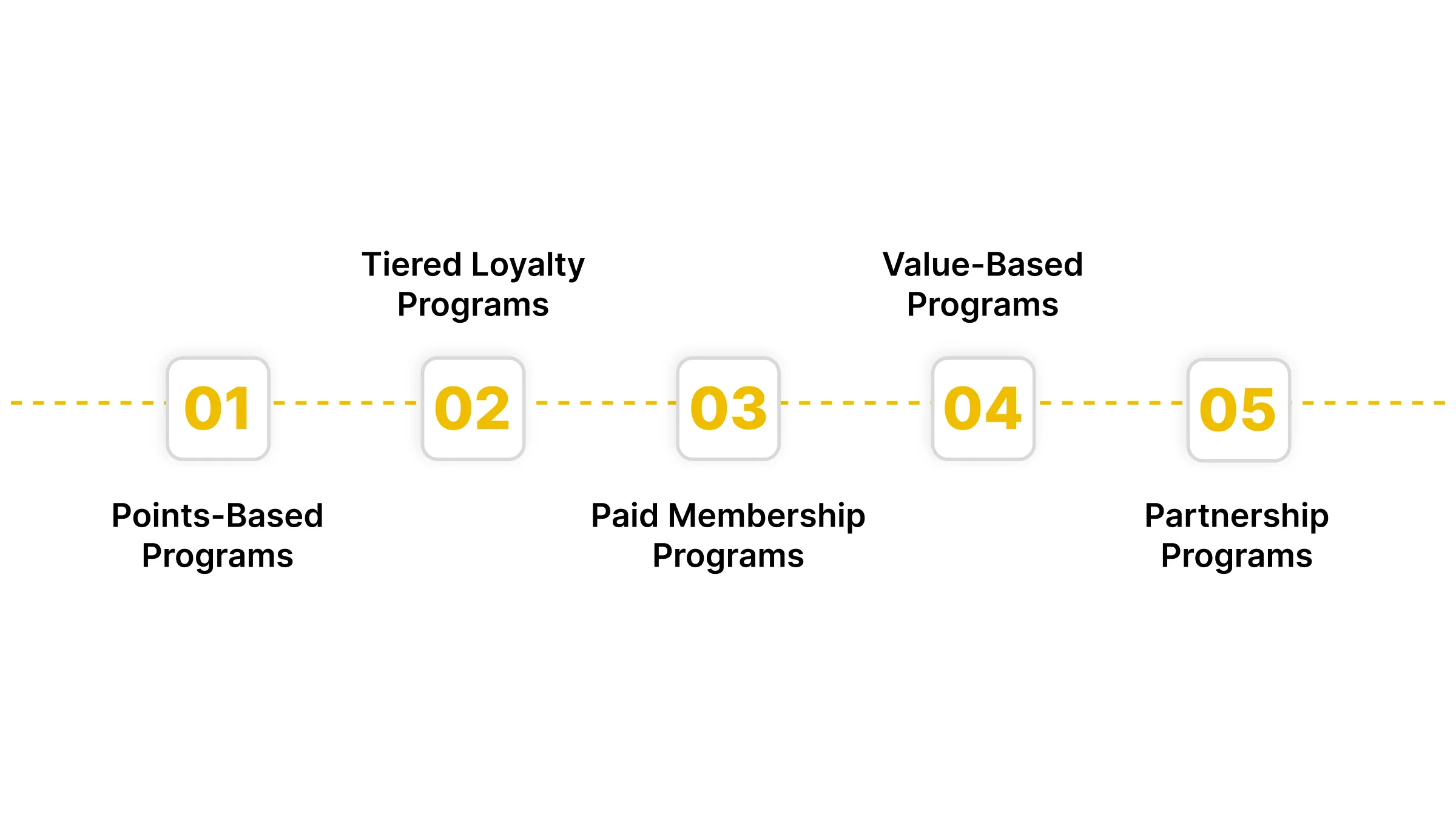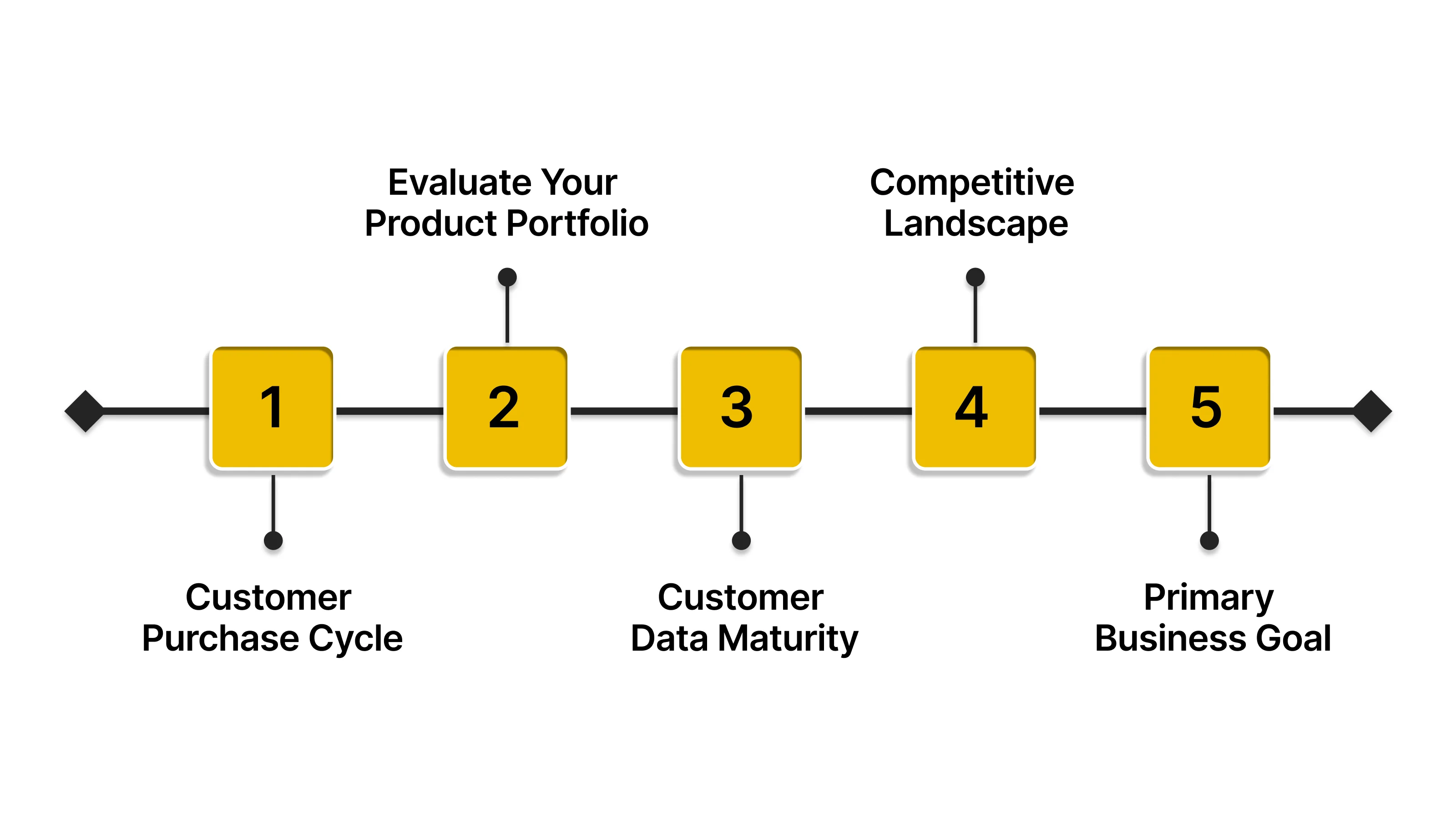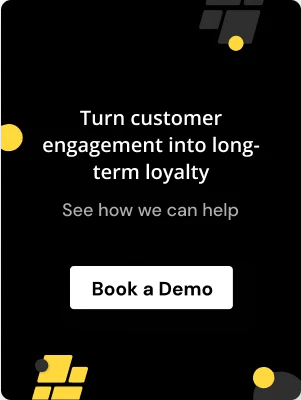.avif)
.avif)
Many businesses struggle to turn one-time buyers into repeat customers. This challenge limits growth and increases marketing costs over time. In fact, acquiring a new customer is five to twenty-five times more expensive than retaining an existing one. Companies often miss the full potential of their existing customer base.
Effective customer loyalty and customer loyalty programs directly solve this retention problem. They systematically reward ongoing engagement and repeat purchases. A well-designed program builds a community of brand advocates.
This guide will share essential tips for creating a successful loyalty strategy. You will learn best practices from top-performing programs. We will also show you how to implement these ideas effectively.
Quick Look
- Choose your program type strategically: points for frequency, tiers for high-value customers, paid for exclusivity, and value-based for emotional connection.
- The best programs create "competitive immunity" by building both emotional and practical switching costs for customers.
- Use customer insights to deliver relevant rewards and communications that increase engagement and redemption rates.
- Align your program with customer purchase cycles and your data capabilities; don't overcomplicate what you can't sustain.
- Successful programs generate their own ROI, like 12% AOV lift and 12.4% of orders from loyalty members.
What Is A Customer Loyalty Program
A customer loyalty program is a structured system for rewarding repeat purchases. It acknowledges and incentivizes your customers' continued business with your brand. Members typically earn points or status through specific actions.
These programs transform transactional relationships into ongoing engagements. Customers receive tangible value for their loyalty beyond the products themselves. This creates mutual benefit for both your business and your customers.
Modern programs often extend beyond simple point collection systems. They might include tiered benefits, exclusive access, or personalized offers. The goal remains building emotional connections and long-term value.
Struggling to demonstrate clear ROI from your customer retention efforts? Nector provides detailed analytics that connect loyalty activities directly to revenue. Book a demo to see how our tracking works.
Also read: CRM Strategies for Improved Customer Retention
Understanding the definition reveals why these programs deliver such significant strategic value.
Why Are Customer Loyalty Programs Important

Loyalty programs deliver measurable advantages beyond simple customer retention. They create a defensible business moat and generate superior customer intelligence. These programs transform customer data into actionable growth strategies and predictable revenue.
A strategic loyalty program provides these distinct competitive advantages:
1. Increase Customer Lifetime Value
Loyal members consistently demonstrate higher spending patterns than non-members. They develop purchasing habits that favor your brand over time. This predictable revenue stream supports better business planning and investment. You maximize returns from your initial acquisition costs.
2. Generate Valuable Customer Data
Every program interaction provides insights into customer preferences and behaviors. This data reveals purchasing patterns and product affinities you can leverage. You gain direct feedback for product development and service improvements. These insights are unavailable through other marketing channels.
3. Create Brand Advocates
Satisfied program members naturally share positive experiences with their networks. They provide authentic social proof that money cannot easily buy. These organic recommendations carry significantly more weight than paid advertising. Your best customers become your most effective sales team.
4. Build Competitive Immunity
A strong loyalty program creates significant switching costs for customers. Members develop emotional and practical reasons to stay with your brand. This makes them less vulnerable to competitor promotions and price changes. Your customer base becomes a durable business asset.
Also read: What Is Loyalty Management? Benefits & Tips for D2C Brands in 2025
These compelling benefits are achieved through various program structures that suit different business models.
What Are the Different Types of Loyalty Programs?

Selecting the right program structure is crucial for aligning with your business model and customer expectations. Different programs leverage distinct psychological triggers and operational requirements.
Your choice should reflect your brand identity and customer engagement goals. The optimal model creates mutual value for both your business and your members.
Businesses typically implement these primary types of loyalty programs:
1. Points-Based Programs
Customers earn currency for purchases and other valuable brand interactions. They can later redeem accumulated points for rewards, discounts, or products. This straightforward system is easy for customers to understand and track. It works well for businesses with frequent purchase cycles.
2. Tiered Loyalty Programs
Members progress through different levels based on their spending or engagement. Each tier unlocks increasingly valuable benefits and exclusive perks. This gamified approach motivates customers to reach the next status level. It effectively rewards your most valuable customers.

3. Paid Membership Programs
Customers pay an upfront fee for premium benefits and exclusive access. This model generates immediate revenue while securing long-term customer commitment. It works exceptionally well for brands with strong customer loyalty. Amazon Prime is a prominent example of this model.
4. Value-Based Programs
These initiatives align with customer values beyond simple transactional rewards. Programs might feature charitable donations or sustainability-focused benefits. They build deep emotional connections with socially conscious consumer segments. This approach often generates significant brand advocacy.
5. Partnership Programs
Businesses collaborate to offer combined rewards across multiple brands. This expands value perception and reaches new customer audiences effectively. Customers appreciate the broader redemption options and increased flexibility. Airline and hotel alliances demonstrate this model's power.
Also read: Loyalty Pricing: How to Apply and Understand Its Importance
Knowing the options available leads directly to selecting the optimal structure for your brand.
Tips To Choose The Right Program For Your Business

Selecting the optimal loyalty program requires aligning its structure with your specific business objectives and customer behavior. A mismatch can lead to low participation and minimal impact on customer retention.
Your choice should leverage your unique strengths while addressing customer needs directly. This strategic fit determines your program's long-term success and profitability.
Consider these essential factors when evaluating program options:
1. Analyze Your Customer Purchase Cycle
Examine how frequently your customers typically make purchases from your business. Businesses with daily or weekly transactions suit simple point systems well. Companies with annual purchase cycles may prefer tiered status programs. Understanding this rhythm ensures your program remains relevant.
Why it works best: This alignment keeps the program top-of-mind during natural repurchase moments. It prevents member disengagement between long purchase intervals.
2. Evaluate Your Product Portfolio
Assess whether you offer single products or a diverse range of categories. A broad catalog supports flexible point redemption across multiple items. Limited product lines may benefit from exclusive access or experiential rewards. Your inventory directly influences what members find valuable.
Why it works best: Rewards that integrate seamlessly with your offerings feel more authentic. Customers appreciate redemption options that complement their original purchase interests.
3. Consider Your Customer Data Maturity
Review your current ability to track and analyze individual customer behavior. Sophisticated programs require robust data systems for personalization. Simpler programs work effectively with basic purchase history tracking. Your technical capabilities should match your program's complexity.
Why it works best: Programs that leverage available data deliver more relevant experiences. This prevents overpromising features your systems cannot support reliably.
4. Assess Your Competitive Landscape
Identify what loyalty initiatives your direct competitors currently offer customers. Look for opportunities to differentiate through unique rewards or better value. Avoid simply copying programs that don't match your brand identity. Your program should stand out while meeting market expectations.
Why it works best: Differentiation prevents direct comparison on reward value alone. Unique programs create competitive advantages that are difficult to replicate.
5. Define Your Primary Business Goal
Determine whether you prioritize customer retention, increased spending, or new referrals. Retention-focused goals align with points and tier-based systems. Advocacy goals suit referral and community programs better. Clear objectives ensure your program design supports specific outcomes.
Why it works best: Programs with focused goals deliver measurable results more effectively. They avoid confusing members with too many competing engagement options.
Also read: How to Create the Best WooCommerce Loyalty Program
Overwhelmed by the complexity of launching a loyalty program? Nector handles setup, tracking, and reward fulfillment in one platform. Start a free trial to see how simple implementation can be.
Once you've selected your program type, implementation excellence determines its ultimate success.
Best Practices for Customer Loyalty Programs

Effective program execution requires attention to psychological triggers and operational excellence. These practices transform a basic rewards system into a powerful retention engine.
They ensure your program delivers genuine value to both your business and members. Implementation quality often determines long-term participation and program success.
Apply these proven practices to maximize your loyalty program's impact:
1. Keep the Value Proposition Clear and Simple
Members should immediately understand how to earn and redeem rewards. Complex rules or hidden requirements create friction and reduce participation. Use straightforward language and transparent terms throughout the member journey. This clarity builds trust and encourages ongoing engagement.
Successful implementation looks like this:
- Members can explain the program basics in their own words
- Enrollment and first reward achievement happen within days
- Program terms are easily accessible and understood
2. Offer Immediate and Attainable Initial Rewards
Provide members with their first reward quickly after joining your program. Early positive experiences create momentum for continued participation. The path to initial rewards should feel easily achievable for most members. This early success establishes positive program associations.
Successful implementation looks like this:
- Welcome bonuses or sign-up points are awarded instantly
- First redemption occurs within the first few member interactions
- Members describe the program as "worthwhile" from the beginning
3. Personalize Communications and Rewards:
Use member data to tailor messages and offer relevant reward options. Generic mass communications feel impersonal and reduce engagement impact. Recognition of individual preferences demonstrates genuine customer understanding. Personalization significantly increases redemption rates and satisfaction.
Successful implementation looks like this:
- Reward recommendations align with past purchase history
- Communications use member names and reference their activity
- Members report feeling recognized as individuals
4. Create Multiple Engagement Pathways:
Design various ways for members to interact beyond simple purchases. Include social sharing, reviews, and community participation as earning opportunities. Different engagement types appeal to diverse customer preferences and behaviors. This approach captures value from your entire customer base.
Successful implementation looks like this:
- Members engage through both purchasing and non-purchasing activities
- Program participation continues between purchase cycles
- Members naturally share the program within their networks
5. Maintain Consistent Program Visibility:
Integrate your program prominently across all customer touchpoints. Include mentions in receipts, email signatures, and customer service interactions. Regular visibility reminds members of available benefits and opportunities. Consistent presence prevents program awareness from fading over time.
Successful implementation looks like this:
- Members encounter program reminders during natural interactions
- Staff can knowledgeably discuss program benefits
- Program participation remains steady without heavy promotion
Also read: Understand Loyalty Program Optimization That Enhances Revenue
Increasing Average Order Value by 12% with Loyalty
Amrutam, an Ayurvedic wellness brand, implemented a structured loyalty program to deepen customer relationships. They created a points system rewarding purchases, reviews, and social media engagement. This approach encouraged both repeat purchases and higher-value orders from members.
The program generated 12.4% of all orders directly through loyalty member activity. It also achieved a 12% increase in average order value from participating customers. This demonstrated how strategic rewards can simultaneously drive frequency and order size. The brand successfully increased customer lifetime value through systematic engagement.
Achieving similar outcomes requires the right tools to manage program complexity effectively.
Build Your High-Converting Loyalty Program with Nector
Manual loyalty program management often overwhelms e-commerce teams with operational complexity. Tracking points across different customer actions requires constant attention and resources.
Personalizing experiences for each member becomes nearly impossible to maintain at scale. These operational hurdles prevent your loyalty program from reaching its full potential.
Nector provides a complete platform for automating your customer loyalty strategy. Our system handles program setup, point tracking, and reward fulfillment automatically. You can launch a sophisticated loyalty program without technical complexity or manual effort. This approach transforms loyalty management from a burden into a competitive advantage.
Nector’s loyalty features deliver comprehensive program control:
- Customizable Program Design: Create loyalty programs that match your brand identity and specific business objectives perfectly.
- Flexible Reward Structures: Offer points, discounts, products, or exclusive access to reward customer loyalty.
- Automated Tier Systems: Implement VIP levels that unlock special benefits for your best customers automatically.
- Seamless Platform Integration: Connect Nector with your existing e-commerce store and marketing tools effortlessly.
- Performance Analytics: Track customer engagement and program effectiveness with detailed, actionable insights.
This comprehensive approach demonstrates a clear path from strategic planning to successful execution.
Conclusion
Effective customer loyalty programs build lasting relationships beyond simple transactions. They systematically increase customer lifetime value and reduce acquisition costs. The right program structure aligns with your specific business goals and customer behavior.
Manual program management often creates operational complexity for e-commerce teams. Nector automates program setup, tracking, and reward fulfillment in one platform. This eliminates the technical barriers to running a sophisticated loyalty system.
Start building your high-converting loyalty program with Nector today. Create meaningful customer relationships that drive sustainable growth for your brand. Book a demo.
FAQs
1. What are the 4 types of customer loyalty programs?
The four primary types are points-based, tiered, paid membership, and value-based programs. Points systems reward transactions with redeemable currency. Tiered programs offer escalating benefits for increased engagement.
Paid memberships provide premium access for an annual fee. Value-based programs align with customer ethics and social causes.
2. How do I create a successful customer loyalty program?
Start by analyzing your customer purchase frequency and available product catalog. Choose a program structure that matches your business model and technical capabilities. Ensure immediate reward accessibility and clear value communication from day one. Personalize experiences using customer data to increase relevance and engagement.
3. What makes a loyalty program successful?
Successful programs maintain absolute simplicity in their rules and reward structure. They deliver personalized experiences that make members feel recognized. Multiple engagement pathways accommodate different customer preferences and behaviors. Consistent visibility across all touchpoints maintains program awareness and participation.
4. How much does a customer loyalty program cost?
Costs vary significantly based on program complexity and technology requirements. Simple point systems have lower implementation costs than sophisticated tiered programs. Paid membership programs often generate immediate revenue, offsetting setup expenses. The strongest ROI comes from increased customer lifetime value and reduced acquisition costs.
5. What is the most popular loyalty program?
Amazon Prime represents one of the most successful paid membership programs globally. Starbucks Rewards excels in points-based engagement with mobile integration. Sephora's Beauty Insider demonstrates effective tiered structure implementation across beauty retail. Airlines and hotels typically lead in partnership program innovation.
Start Building Customer Retention That Lasts



.webp)



.png)


